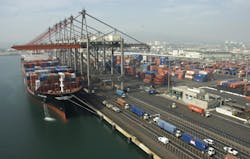The pace of re-shoring and near-shoring – whereby manufacturing operations are relocated back to the U.S. directly under the former or to nearby Mexico and Latin America countries via the latter – is slowing down, according to a new study by global consulting firm A.T. Kearney.
As a result, freight imports through U.S. ports are expected to remain strong near term, with only some localized demand for truck and rail service seeing an uptick due to re-shoring activity, noted Pramod Gupta, a principal with A.T. Kearney principal and co-author of the firm’s 2014 Re-shoring Index report.
“This is a strategy still very much in its infancy,” Gupta told Fleet Owner. “There have been 700 recorded cases of re-shoring cases so far and they cut across all sectors of industry.”
He explained that the decision to engage in re-shoring or near-shoring depends on several key factors that, in turn, hinge partly on transportation needs.
“The decision to keep manufacturing overseas is really driven by labor costs,” Gupta said. “Labor-intensive industries will continue to remain offshore. The primary reason for bringing operations back is to shorten the supply chain in order to meet customer delivery needs. Getting closer to the customer is the main reason driving relocations to the U.S., Mexico and Latin America.”
He added that the top three re-shoring industries to date, as measured by the number of cases in A.T. Kearney's database, are; electrical equipment, appliance and component manufacturing, at 15%; transportation equipment manufacturing, with 15%; and apparel manufacturing, which previously had not been expected ever to come back, with 12%.
Again, according to the firm’s research, improvement in delivery times is why executives choose to favor re-shoring efforts, with quality improvement a close second and followed by brand/image.
Gupta also noted that while there has been an overall lift in U.S. manufacturing for five straight years since 2009, imports of offshored manufactured goods into the U.S. have increased at a faster rate than any return of manufacturing operations to U.S. soil and, for the 14 top offshoring locations combined, amounted to $630 billion in 2013.
"While the so-called re-shoring trend has helped improve the mood of U.S. manufacturing since the Great Recession, the reality is that the import value of manufactured goods into the U.S. from 14 low-cost Asian countries has grown at an average of 8% per year in the last five years," he explained.
“There’s still a significant cost advantage to locating operations in low-cost labor countries like China, which is why we don’t expect a huge ‘wave’ of re-shoring to occur anytime soon,” Gupta added. “But it’s also an initiative that remains very much in the infancy stage.”
About the Author
Sean Kilcarr
Editor in Chief
Sean Kilcarr is a former longtime FleetOwner senior editor who wrote for the publication from 2000 to 2018. He served as editor-in-chief from 2017 to 2018.
